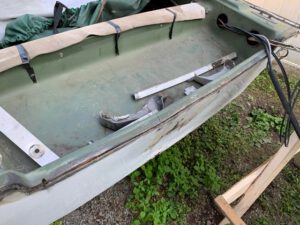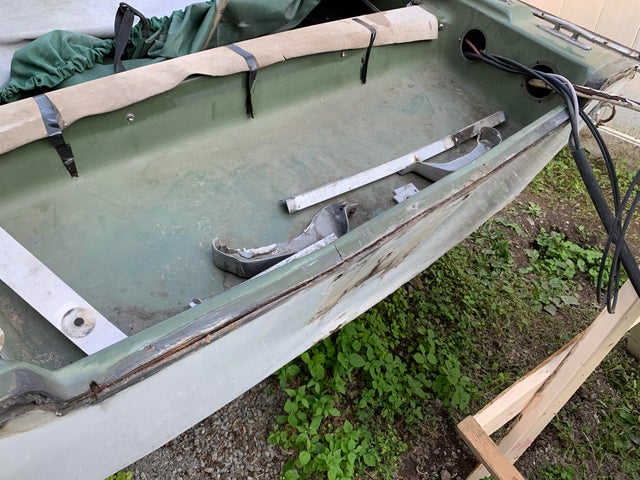The key to Boat Transom Repair is accessing the bad wood and getting it dry. This is why it is important to use our layup and laminating resin in these repairs; it sets slower, so the water has time to evaporate before the epoxy hardens and shatters under load.
The transom is a critical part of the hull’s structure. It must be able to support the weight of the engine and transfer the thrust and force that are applied. A rotted transom can lose its integrity and, in extreme cases, lead to the loss of the motor or even cause the boat to sink.
A rotting transom is an unavoidable fact of life for many owners of older fiberglass motor boats on our waters. These great little powerboats look so pretty that it is hard to believe that the underbelly can get rotten. However, the truth is that these lovely machines have some major weaknesses. The main one is that polyester fiberglass allows a small amount of water to pass through it. This inevitably means that the timber underneath is exposed to moisture. If this wood is wet for a prolonged period of time, it can become the home of dry rot fungal spores that eat away at the timber.
The first step in repairing a rotting transom is to gain access to the wood underneath. This may seem like an obvious thing to do, but in reality, it is not always easy. It is very important that a skilled tradesman be employed for this task and not a well-meaning mate or neighbor. A professional marine builder or shipwright will have tools and experience that can give a thorough assessment of the condition of the transom without the need for destructive core sampling.
An assessment can be done using non-invasive methods such as percussion testing or a moisture meter. These tools can determine the percentage of moisture in the wood. If the reading is 5% to 15%, this is considered normal. If the moisture content is 20% or above, then there is a serious issue, and some type of core sampling would need to be carried out to see how deep the rot has penetrated the wood.
Once you have access to the bad wood, a few basic repairs can be undertaken. Firstly, the old rotten material should be cut out, and then the wood that is left needs to be dried out. This will allow the epoxy products to bond with the remaining wood. It is essential to use a product that will kill any fungi living in the wood and help restore the strength of the transom.
The Basics
The transom is a major structural part of any fiberglass powerboat and must be able to support the weight of the engine, maintain the shape of the boat, and provide mounting points for holdowns and towing eyes. It must also be able to let water in and out of the hull and allow for the vibrations, torque, and thrust of the outboard motor.
One of the most common problems with a boat transom is rot. When a transom starts to rot, it is often caused by moisture penetrating the fiberglass skin through fasteners, drains, cutouts, and screws. Over time, this moisture will cause wood rot that can weaken the structure of the transom and, if left untreated, eventually result in the loss of the entire core.
To prevent this, it is important that all screw holes in the transom are properly coated and sealed with epoxy to prevent water from entering through the screw hole and rotting the interior of the transom. This is especially true of the screw holes for the motor mounts and the transducer mounts.
Moisture can be caused by many factors, such as leaking stern drives or a wet trailer. It can also be caused by a loose or defective thru-hull unit or a poorly functioning ventilation system. It can be difficult to determine the source of the moisture, so it is important to conduct a thorough inspection and identify any areas of concern.
If a significant amount of the transom structure is rotted, it will be necessary to remove the entire transom core and replace it with fresh material. This can be a very labor-intensive job, but it is the only way to guarantee that the new transom will be structurally sound.
Once the old transom has been removed and the area thoroughly cleaned up, it is time to get started on the transom repair process. First, the exterior of the transom glass should be taped off with painters’ tape. This will help to protect the surrounding fiberglass and also allow for easy cleaning of any old bolt or transducer holes once they are filled with epoxy.
Advanced Techniques
The transom is an important structural component in a boat, and when it rots, the entire vessel can suffer. Luckily, there are many ways to recognize the presence of rot and take care of it quickly. These methods range from simple visual inspection to tapping the surface of the transom with a mallet to reveal areas of delamination. Inspecting the area around an outboard motor mount or any other transom-mounted components will also help identify issues early on.
An ounce of prevention is worth a pound of cure. Regularly rinsing your boat’s transom will prevent the buildup of salt and other contaminants, which can contribute to the formation of dry rot. It is also important to inspect for cracks and other visible damage on a regular basis, especially before launching your boat into freshwater or saltwater.
A damaged boat transom can have a serious effect on the performance and safety of your vessel, and in severe cases, it may even cause your engine to fall off. A rotting transom can also allow water to enter the boat, which can lead to serious damage.
There are some situations where it may be possible to replace a bad section of the transom, but this is generally only feasible in very small boats and requires extensive experience with laminate work. If you are considering replacing a bad part of your transom, it is always best to consult a marine fiberglass specialist for advice.
Another option is to remove the existing transom, clean out the bad wood, and allow the interior of the boat transom to thoroughly dry. Then, the bad wood can be removed and replaced with new wood that has been saturated with CPES (TM) before being laid up and bonded into the hull. This method is less expensive than a full replacement of the transom, but it can be much more difficult to do properly.
The final approach is to re-build the entire boat transom using fiberglass and epoxy. This can be done either by building a core outside the hull and bonding it in or by laminating it one layer at a time into the hull itself. This is usually the preferred method, as it is more accurate than trying to match the existing hull material. In either case, all new wood used to build the core should be saturated with CPES (TM) and treated with layup and laminating resin before being placed in the hull.
Materials
The transom is the structure that supports the stern-mounted motor, propeller, and other equipment. It is also a structural component that reinforces the back of the boat and transfers stresses to the rest of the hull. Proper maintenance and care of the transom are essential to the overall condition of the boat. The transom should be inspected regularly to look for signs of damage, such as cracks or rot. If problems are found, they should be repaired promptly. The boat owner should also be sure that all penetrations through the transom, such as screws and engine bolts, are properly sealed to prevent water from entering and causing damage.
A rotten boat transom should be removed and replaced as soon as possible. The simplest and most effective way to do this is to cut out the damaged area of the transom with a utility knife and remove the rotted wood. The remaining good wood can then be used as a template to mark the location of the new transom.
If the rotted timber core is not removed and the damaged area is left to dry, it will eventually delaminate and become irreversibly damaged. If this happens, then it will be necessary to replace the entire transom.
It is important to use the best materials when repairing the transom. Good-quality plywood will provide a strong and long-lasting repair. It is also important to use proper epoxy formulations. Our Layup and Laminating Resin is the ideal product for this type of job. It has a slower set time and is much stronger than standard polyester resins. It is important to follow the manufacturers’ recommendations when using this product.
Many times boat owners will try to “band aid” a transom by pouring some sort of bandage into a hole that has been cut from the bottom of the rotten area of the transom. This only works until the next flex or load is placed on the area. At that point, the bog will either break free of the rotten wood or, worse, it will shatter completely.

